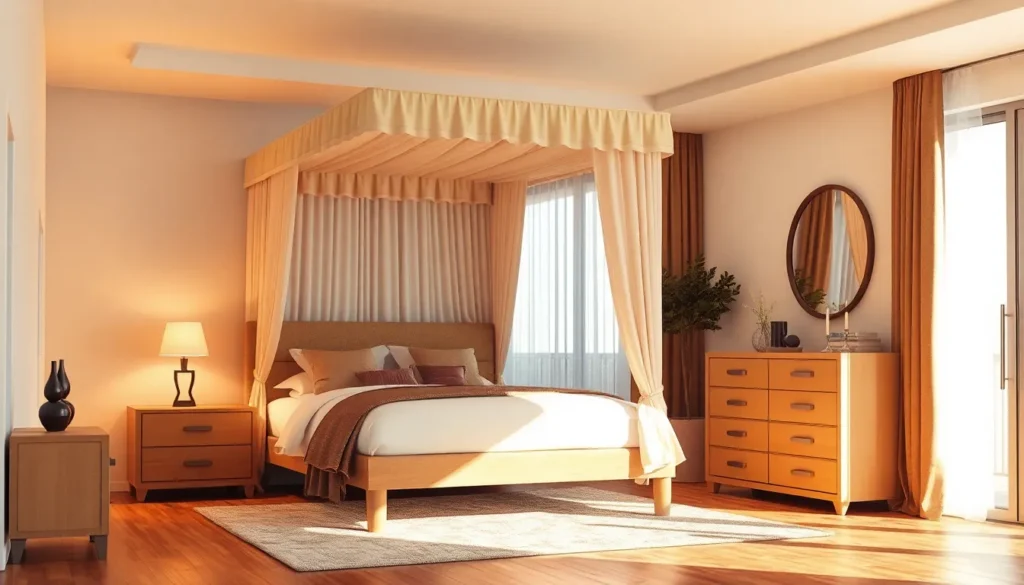Table of Contents
ToggleWhen it comes to furnishing a bedroom, the names of the pieces can sound like a secret language only interior designers understand. From the majestic “canopy bed” that makes you feel like royalty to the humble “nightstand” that holds your midnight snacks, each item has its own flair. But don’t worry; no need to hire a translator just yet!
Types Of Bedroom Furniture
Various pieces of furniture contribute to the functionality and aesthetic of a bedroom. Each item plays a unique role, enhancing comfort and style.
Beds
Beds serve as the centerpiece of any bedroom. They come in several styles, including platform, sleigh, and canopy beds. A mattress rests atop the bed frame, providing necessary support for restful sleep. Sizes vary, with options like twin, full, queen, and king accommodating different needs. Quality materials, such as wood or metal, enhance durability and appearance.
Nightstands
Nightstands offer practicality beside the bed. Commonly featuring drawers or shelves, they provide storage for essentials like books and lamps. Styles range from modern to traditional, adapting to various bedroom designs. Height and size align with the bed for ease of access, ensuring items are within reach. Many nightstands include decorative elements, enhancing the overall decor.
Dressers
Dressers play a vital role in bedroom organization. They typically feature multiple drawers for clothing storage, keeping items neatly tucked away. Styles vary, including low and wide designs or tall and narrow configurations. Wood, metal, and composite materials contribute to distinct aesthetics. Some dressers may even include mirrors, offering dual functionality.
Wardrobes
Wardrobes serve as standalone clothing storage solutions. They often house hanging space, drawers, and shelves, accommodating various garments. Individual designs cater to different tastes, ranging from minimalist to ornate. Many wardrobes feature doors that conceal contents, maintaining a tidy appearance. They prove especially useful in homes lacking built-in closets.
Vanities
Vanities enhance a bedroom’s functionality and style. These pieces typically feature a tabletop and a mirror, making them ideal for grooming and personal care. Styles vary widely, with some incorporating drawers for storage of beauty essentials. The function of a vanity extends beyond storage; it also adds an element of elegance. Placement often considers natural light to create a pleasing grooming experience.
Popular Bedroom Furniture Names

Several popular names describe essential bedroom furniture pieces. Each type presents its unique features and benefits.
Canopy Bed
The canopy bed stands out with its elegant and dramatic design. Traditionally, these beds feature four posts that extend uptoward a fabric drape. This setup allows for added privacy and a touch of luxury. Varieties exist, including modern and vintage styles, accommodating diverse tastes. These beds work well in both spacious and cozy bedrooms, enhancing the overall aesthetic.
Platform Bed
Platform beds are known for their sleek and minimalist design. Typically, these beds rest directly on a sturdy base or a framework that eliminates the need for a box spring. They provide low-to-the-ground access, which suits various age groups. Additionally, platform beds often offer built-in storage options, maximizing bedroom space. This practicality appeals to individuals seeking modern and functional solutions.
Sleigh Bed
The sleigh bed features a distinctive curved shape, resembling a sled. Designers often craft these beds from solid wood, contributing to their durability. The unique silhouette adds character to bedroom decor, whether in traditional or contemporary spaces. Often, users appreciate the spacious designs , allowing for comfort in sleeping arrangements. Sleigh beds remain a timeless choice for enhancing bedroom style.
Nightstand Variations
Nightstands come in various styles and functions, catering to different needs. Many designs include drawers for hidden storage, while open shelves offer easy access to essentials. Users often choose between single and double nightstands based on bed width. Some designs blend seamlessly with bedroom decor, serving as statement pieces. Overall, nightstands serve both functional and decorative purposes, making them a crucial element in bedroom design.
Choosing The Right Bedroom Furniture
Choosing bedroom furniture involves balancing aesthetics and practicality. Factors like space, style, and function play a crucial role in that decision.
Consider Your Space
Evaluate the dimensions of the bedroom before purchasing furniture. Assessing the floor plan ensures that selected pieces fit comfortably without overcrowding. Consider height, width, and depth when measuring furniture. It’s important to leave enough space for movement. Plan pathways around larger items, ensuring easy access to all furniture. Scale furniture appropriately; larger beds can dominate smaller rooms, while pieces too small may appear lost.
Style Preferences
Identify the desired style for the bedroom, as this sets the tone for furniture selection. Options range from traditional to contemporary, each with distinct characteristics. Traditional styles often feature intricate details and warm colors, while contemporary offers clean lines and minimalism. Mixing styles can add personality but must be done thoughtfully. Color schemes and finishes should coordinate well; matching wood tones unifies the look. Accessorizing with textiles and decorative items can enhance the chosen style, bringing cohesion.
Functional Needs
Determine the bedroom’s functional requirements to maximize utility. Assess how much storage is necessary; options include dressers, nightstands, and wardrobes. Choosing multifunctional furniture, like beds with built-in storage, can save space. Consider preferred activities, such as reading or working, which may necessitate additional furniture like armchairs or desks. Prioritizing comfort is key; selecting quality mattresses and ergonomically designed chairs promotes well-being. Balance functionality with aesthetics to create a harmonious environment.
Caring For Bedroom Furniture
Caring for bedroom furniture ensures longevity and maintains aesthetic appeal. Proper attention enhances both functionality and beauty.
Maintenance Tips
Regular checks extend the lifespan of bedroom furniture. Inspect wood for scratches and dents, addressing these quickly to avoid further damage. Use coasters and placemats to prevent surface wear from drinks and objects. Provide adequate support to beds, ensuring that slats are intact and sags do not occur. Protect furniture from excessive sunlight, which can fade colors over time. Lastly, adjust drawer slides and hinges periodically, promoting easy operation and preventing jams.
Cleaning Techniques
Cleaning methods depend on the material of the furniture. For wooden pieces, dust weekly with a soft, dry cloth to prevent buildup. Use a slightly damp cloth followed by a dry one for deeper cleanings. Upholstered items require vacuuming every few weeks to eliminate dust and debris, while spot cleaning handles stains. Glass surfaces need a streak-free cleaner and a microfiber cloth for a clear finish. Regularly organize items in drawers and on surfaces, enhancing both cleanliness and visual appeal.
Understanding the various names and types of bedroom furniture can significantly enhance one’s ability to create a comfortable and stylish space. Each piece serves a distinct purpose while contributing to the overall aesthetic. By selecting the right combination of furniture, individuals can achieve a harmonious balance between functionality and design.
Taking the time to assess personal needs and preferences ensures that the chosen furniture not only fits the room but also reflects individual style. With proper care and maintenance, these pieces can provide lasting beauty and utility. Embracing the charm of well-named furniture can transform any bedroom into a welcoming retreat.





